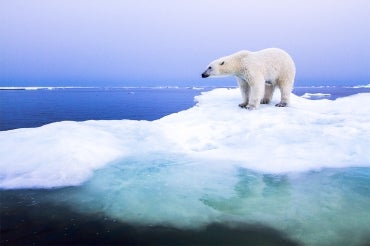Arctic's last refuge for ice-dependent species disappearing as region warms

Published: November 13, 2019
Ice cover in a marine protected area in the Far North – potentially the last refuge for Arctic animals that depend on sea ice for their survival – is disappearing twice as fast as ice in the rest of the Arctic Ocean.
The finding is part of a study recently published in the journal Geophysical Research Letters that also reveals the area is comprised of two dynamic sub-regions.
“(The) area is quite dynamic and we thought we should look at it to try to understand it because no one had actually ever done any work in this area of the Arctic,” says Kent Moore, an atmospheric physicist at the University of Toronto Mississauga and lead author of the new study.
Known as the Last Ice Area, the region is home to the oldest and thickest sea ice in the Arctic. With climate forecasts predicting the Arctic could experience ice-free summers as early as 2030, researchers anticipate this will be the last area ice will be present in the Arctic year-round, making it an important sanctuary for a wide variety of Arctic species.
“Polar bears are obvious,” Moore says. “But seals, walruses, down to small algae – there are actually whole communities of algae that grow on ice – a lot of fish need to feed on the algae. It’s a very complicated food web.”
In August, the Canadian government declared the Last Ice Area a marine protected area, naming it Tuvaijuittuq, meaning “the place where the ice never melts” in Inuktut. Yet little is known about how the ice in this region moves and melts.
That absence of information prompted Moore and his team to explore the ice dynamics of the region. They tracked seasonal changes, modelling ice cover, thickness and motion across the region from 1979 to 2018.
The conventional wisdom was that the Last Ice Area just sits there year after year, Moore said.
But researchers discovered it’s more nuanced than that.
“There’s actually quite a bit of variability of the ice motion within it,” Moore says. “It’s quite dynamic.”
The model revealed two sections in the area – one to the east and another to the west – that have distinct fluctuations seasonally and between years. Ice in the western portion, which is controlled by winds blowing clockwise, has started moving faster – possibly the result of thinning – while eastern ice appears more stable.
There is also high variability in the entire region from year to year, with ice thickness fluctuating by half a metre.
Researchers also found ice is growing thinner in both sections at a rate of 0.4 metres per decade, which amounts to a 1.5-metre loss of ice since the 1970s. That means ice loss in the area is twice that of the rest of the Arctic Ocean.
Moore said they are “just scratching the surface” when it comes to understanding why these changes are happening.
“We may need to go back and revisit how much ice will be present moving forward.”
Moore hopes that people will start to understand the importance of this area, and that Canadians are going to be the ones responsible for managing it.
Despite disappearing at a faster rate, the Last Ice Area will still be the place where ice will remain the longest.
“This area becomes really important because it will be a place where, hopefully, these ice-dependent species will be able to get over that hump, because my hope is eventually we will be able to reduce the effect of global warming,” Moore says.
The Last Ice Area might not be where polar bears make their last stand, but instead where they will survive long enough to repopulate the Arctic, he says.



